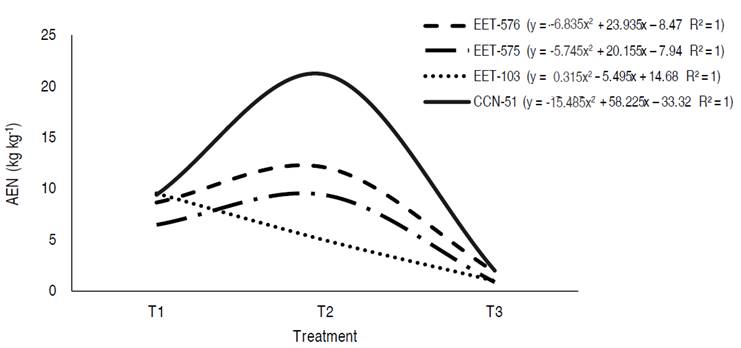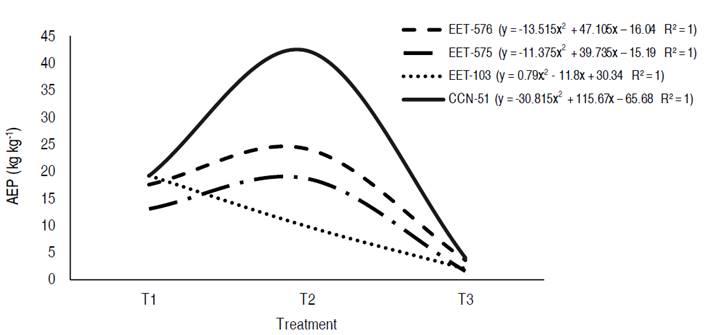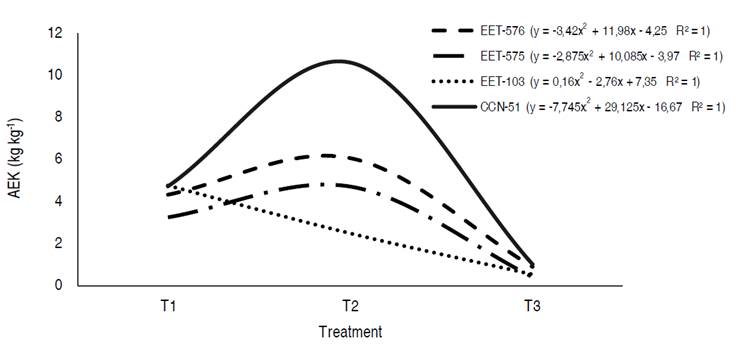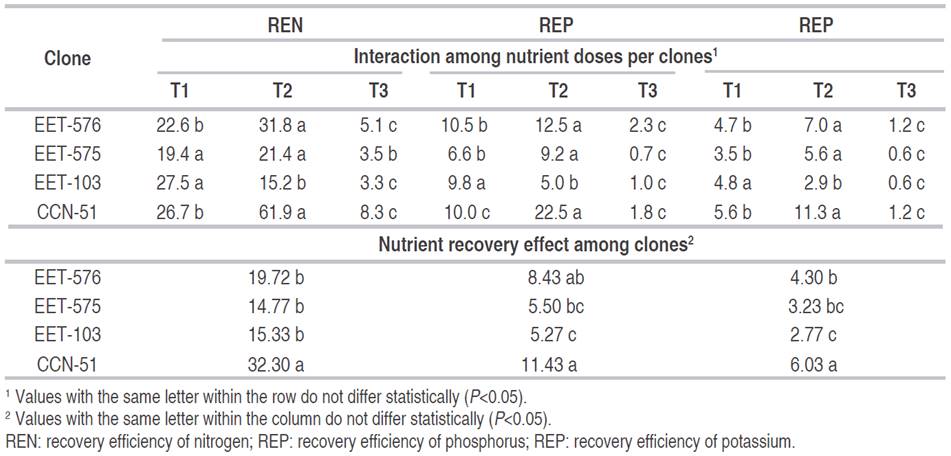Cacao (Theobroma cacao L.) is a perennial crop of great socio-economic importance in Ecuador, providing a source of income for 100,000 families (Pino, 2017); in addition, the country also ranks third in world exports after Côte d’Ivoire and Ghana, contributing 6% to the world production of cacao beans (Fedecacao, 2018).
The cacao that is cultivated in Ecuador is more than 60% fine aroma; however, the yields are lower than 0.25 t ha-1 (Noboa, 2018), resulting from the absence of technological management in farms (Amores et al., 2009), physical and chemical factors of the soil, and the use of clones of low genetic potential (Nakayama, 2010). On the other hand, the lack or excess of fertilization contributes significantly to the yield decrease (Mite, 2016).
Therefore, several researchers have studied the importance of fertilization in cacao (T. cacao L.) crops in order to increase yield. For example, Morais (1998) determined that phosphorus is the nutrient that most limits production in Brazil. Rosas et al. (2019) determined that the acidity of the soil of the Colombian Amazon is an adverse condition to reach maximum performance; however, they found that CCN-51 clone has greater ability in the use of nutrients. The same authors (Rosas et al. 2017) pointed out that applications 7 Mg ha-1 of Mg(CO3)2 and Ca(CO3)2 allow a change in the pH of 4.36 to 6.0 in approximately two months, allowing an increase in the availability of nutrients. Uribe et al. (1998) observed a high response to nitrogen and potassium fertilization, while Mora et al. (2011) reported an increase in yield with different doses of fertilization. Regarding Ecuador, Recalde et al. (2012) showed that the influence of fertilization on yield is evident. However, establishing optimal nutritional management requires efficient use of nutrients, as suggested by Romero et al. (2016), since fertilizing with more nutrients does not guarantee a higher yield (Puentes et al. 2014a).
In that order of ideas, determining the efficient use of nutrients (EUN) will allow the selection of genotypes based on the ability of absorbing nutrients, which could increase crop yields (Baligar et al., 2001), contributing to the mitigation of environmental impacts by the indiscriminate use of fertilizers (FAO, 1999). Stewart (2007) stated that deficit or excess of fertilization causes low yield and quality in cacao crops. Ribeiro et al. (2008) showed that cacao genotypes respond differently to the efficient use of nitrogen. Whereas Puentes et al. (2014b) determined the agronomic and recovery efficiency for N-P-K, as well as the physiological efficiency of the crop (Puentes et al. 2016), suggesting that a low or high amount of fertilizer limits the EUN.
In Ecuador, despite research on cacao nutrition is scarce, Carrillo et al. (2010) reported that balanced fertilization has benefits on the physiology and architecture of the plant. Recalde et al. (2012) stated the beneficial effect of fertilization on the crop. Amores et al. (2010) reported that the beginning of the productive stage of the crop requires 212, 23, and 321 kg ha-1 of nitrogen, phosphorus, and potassium, respectively; as well as 140, 71, 7.1, and 0.9 kg ha-1 of calcium, magnesium, manganese, and zinc, respectively. However, studies in cocoa have not evaluated the efficient use of nutrients, and the fertilizations that are carried out do not consider nutrient recovery efficiency results to determine the doses to be applied. This current practice can lead to underdosing or overdosing without correlating the amount of fertilizer used with crop production. Puentes’ et al. (2014a) research becomes very important in that sense; however, it must be clarified that they worked in soils of very good fertility and with different clones. In their investigation, clones EET-576, EET-575, EET-103, and CCN-51 were used because Amores et al. (2006), determined, in a study conducted over five years, that those clones had the best yields in the area of the Ecuadorian coast (Los Ríos). Therefore, this research aimed to determine the efficient use of N-P-K in terms of agronomic efficiency and fertilizer recovery in the fine aroma clones EET-576, EET-575, EET-103, and CCN-51 in the Province of Los Ríos-Ecuador.
MATERIALS AND METHODS
The research was conducted in 2016 and 2017 at the Mocache cacao farm located in Pajarito, Province of Los Ríos (1°03’18”S and 79°25’24”W), at 73 m.a.s.l. The climatic conditions on average are 77.4% relative humidity, 24.2 °C annual temperature, 1,537 mm annual precipitation, and solar brightness of 823 light hours per year (INIAP, 2015). The soil, classified as Typic hapludalfs (Sevillano et al., 2012), was sampled two months before the application of fertilizers, collecting 15 subsamples at a 0.3m depth and 1.5m from the trunk of the cacao plants for a composite sample. The physical and chemical analysis of the soil showed no limitations for the development of the crop (Amores, 1992); indicating loamy textural class, low apparent density, moderately acidic pH, low organic matter content, medium cation exchange capacity (CIC), high P and K+ content and low levels for exchangeable Al3+ (Table 1).
The experiment design consisted of randomized complete blocks with an arrangement of divided plots (main plot: cocoa clones; subplots: treatments) with four treatments and four repetitions; the experimental unit was made up of four trees. Self-compatible clones of fine flavor and aroma cocoa with six years of age, three from the Tropical Experimental Station (EET-576, EET-575, EET-103) and one from the Castro Naranjal Collection (CCN-51) were used, sown at 3 m between plants and 3 m between rows for a planting density of 1,111 plants per hectare. The test area was 2,304 m2 with 256 plants (64 for each clone).
The evaluated treatments included different doses of N-P-K, they were designed using the treatment with the highest yield obtained by Puentes et al. (2014a) and the nutrient ratios of 2:1 for N/P and 1:2 for N/K. Meanwhile, T2 was similar to the one evaluated by Puentes et al. (2014a), and, according to this treatment, T1 was 20% less, TR was 40% less (natural N-P-K concentration of soil), and T3 was 20% more than T2 (Table 2).
The application period of fertilizers was divided into three times, 33% in each part: the first part at the beginning of the rainy season (January), the second part at the end of the rainy season (May) and the third part in the dry season (September). Before starting the experiment, the fruits that had more than three months were eliminated to achieve uniform production (Puentes et al., 2014b). The foliar sampling consisted of taking the fourth leaf of branches located in the middle third of the cacao plants. It was collected a total of 60 leaves per sample (INIAP, 2016) to determine N, through Kjeldahl method; P, through colorimetry; and K, through atomic absorption. Also, the content of N, P, and K in cocoa beans was determined. The coca beans were obtained from ten completely mature pods, which were selected from each clone in each treatment. This sampling was done from the third semester of study to ensure the plant response to the treatments.
The yield was calculated, as suggested by Puentes et al. (2014a), considering the number of pods per tree, the grain index (GI), the number of grains per pod, and the planting density. The GI was determined with Equation 1, proposed by Allen (1987)
The efficient use of N-P-K as a function of the recovery efficiency of fertilizer (RE) indicates the ability of the plant to absorb the nutrients applied to the soil, which was determined with Equation 2, proposed by Baligar et al. (2001).
Where:
Re: Recovery efficiency of fertilizer
EN(f): Extraction of nutrients in grains of the fertilized treatment
EN(t): Extraction of nutrients in grains from the control treatment
CNA: Amount of nutrient applied with the fertilizer
The agronomic efficiency indicated the yield increase in kilograms of dry grain for each kilogram of applied nutrient, which was determined with Equation 3, proposed by Baligar et al. (2001).
Where:
AE: Agronomic efficiency
R(f): Grain yield of the fertilized treatment
R(t): Yield of the control treatment grain
CNA: Amount of nutrient applied with the fertilizer
The data of efficiencies in the use of N-P-K and yield were subjected to Analysis of Variance (ANOVA) and Tukey’s HSD (honestly significant difference) test at a probability level of 5%, and correlations and regressions using the Statistical Analysis System (SAS) program.
RESULTS AND DISCUSSION
Agronomic efficiency of N-P-K in the cacao clones
The agronomic efficiency of N-P-K showed highly significant differences (P<0.01) because of the clone and treatments according to the Tukey’s test.
Meanwhile, the highest nitrogen agronomic efficiency (AEN) was seen in clone CCN-51 in the T2 treatment with 21.19 kg kg-1, which means that, for each kilogram of nitrogen applied, the yield increased by 21.19 kg of dry cacao, followed by clone EET-576 in T2 (12.06 kg kg-1), EET-103 in T1 (9.5 kg kg-1), and EET-575 in T2 with 9.39 kg kg-1 (Figure 1). These AEN values exceeded those reported by Puentes et al. (2014a); considering that there was greater fractionation (three times) concerning the mentioned study. CCN-51 excelled in terms of the AeN in the edaphoclimatic conditions of this experiment, surpassing the other clones.
T3 treatment presented the lower values for all the clones, which coincides with the results of Apáez et al. (2013), who reported a greater amount of fertilizer decreases the efficiency in the absorption of nitrogen. This efficiency decrease can be attributed to the fact that higher doses of fertilizers modify the nutrient balance in the soil solution (Ferraris et al., 2016). A negative effect can be caused, an antagonism, which would reduce the absorption of other nutrients. For example, if N is added as ammonia, the absorption of other cations such as Ca2+, Mg2+ or K+ could be reduced.
In phosphorus (Figure 2), clone CCN-51 showed the highest agronomic efficiency in T2 (42.39 kg kg-1), followed by clone EET-576 in T2 (24.11 kg kg-1), EET-103 in T1 (19.33 kg kg-1), and clone EET-575 in T2 (18.78 kg kg-1), and the lowest efficiency was seen in T3 for the four clones. Similar results were obtained by Puentes et al. (2014a); however, the AEP values were higher because of the low availability of phosphorus in the experiment soil, making the response to fertilization more efficient, as suggested by Díaz et al. (2014) and Covarrubias et al. (2005).
Figure 3 shows that the higher AEK values were in T2 for clones CCN-51, EET-576, and EET-575, with an increase of 10.6 kg, 6.03 kg, and 4.7 kg, respectively, for each kilogram of potassium applied with the fertilizer, while EET-103 presented its highest value in T1 (4.75 kg kg-1). These results are higher than those reported by Puentes et al. (2014a), which is considered normal since the plants do not respond efficiently when K concentrations are high in the soil (Marschner, 1995), as happened with the potassium in the experiment soil.
Efficiency recovery of NPK in the cacao clones
The recovery efficiency of N, P, and K showed highly significant differences (P<0.01) because of the clone and treatments according to the Tukey test (Table 3).
The recovery efficiency of nitrogen (REN) showed the highest efficiency in the CCN-51 clone in the T2, followed by EET-576 in T2, EET-103 in T1, and EET-575 in T2 and the lowest efficiency in T3 for all clones (Table 3). These values are higher than those reported by Puentes et al. (2014a); in the CCN-51 clone of 100% of the fertilizer applied, more than 50% was recovered, exceeding the report by Dass et al. (2015), who indicated that the plant recovers 50% of what was added, and the rest is exposed that can be lost by leaching, volatilization and runoff. However, according to Baligar et al. (2001), the REN below 50% for the remaining clones was considered normal.
The cacao clones showed different percentages of nitrogen recovery, CCN-51 being the one that obtained the highest recovery efficiency of N, for the remaining clones the value was lower, similar to results found by Ribeiro et al. (2008), indicating that the cacao genotypes, although they have a close genetic relationship, differ in their ability to extract nitrogen. Likewise, the interaction of plants with environmental factors such as solar radiation, rainfall, temperature, and microorganisms present in the soil greatly influence the efficient use of nitrogen (Baligar et al. 2001). Some conditions that could affect the investigation in the rainy season (January to May), since the high rainfall (1537 mm) lead to a greater loss of nutrients and that there is little aeration for the activity that microorganisms must meet.
For the recovery efficiency of phosphorus (ReP), it is observed that the highest recovery for clones CCN-51, EET-576, and EET-575 was seen in T2, while for EET-103 was in T1, attributing itself, that with the application of the lowest dose of nutrients reached its maximum yield potential. Besides, concerning the other clones, it was the one that obtained the lowest yield, therefore the lowest extraction of nutrients. Lower REP values were observed in T3 for all the clones. These ReP values are greater than the values reported by Puentes et al. (2014a) and Baligar et al. (2001). In general, there were differences in REP between the clones, obtaining the highest value CCN-51, followed by EET-576, EET575, and EET-103, this behavior may be directly related to the climatic conditions of the area under study and the interaction genotype by the environment.
For the recovery efficiency of potassium (REK), it was observed that, as with ren and REP, clones CCN-51, EET-576 and EET-575 obtained their highest REK in T2, while for EET- 103, it was in T1 (Table 2). These values are low when compared with Baligar et al. (2001), but greater than those obtained by Puentes et al. (2014a); these low REK values can be explained by the presence of illite clays in the soil, which have great affinity for K. It is noted that the higher level of fertilization (T3) decreased the efficiency of recovery for the four clones, indicating a limit in the absorption of nutrients for each clone, as suggested by Puentes et al. (2014b).
Yield
The yield showed highly significant differences between clones and treatments; CCN-51 presented the highest yield, with 41.25% more yield than EET-576 obtained in T2, followed by EET- 575 in T2 and EET-103 in T1 (Table 4).
The obtained yields exceeded the values reported by Amores et al. (2009) for clones EET-576 and CCN-51, by 16.6% and 81.9%, respectively, while EET-575 presented a 9.8% lower yield. These values also surpassed those reported by Sánchez et al. (2015), by 127% for CCN-51 and 150% for EET-103. These results differ with the previous authors because the soil of the studied area presented adequate conditions for the development of cocoa (Amores, 1992). Therefore, it is suggested to perform this type of research in all cocoa-producing areas at the national level.
The lower yields were seen in TR (the treatment without fertilization), in the following order: EET-576, EET-575, EET-103 and CCN-51, similar to results obtained by Remache et al. (2017), suggesting that the fertilizer dose in TR was not sufficient to obtain high yields; likewise, the treatment with the highest dose of nutrients (T3) obtained the lowest yield, in comparison with the treatments T1 and T2. According to Puentes et al. (2014a), yield can be affected by excess fertilization, which causes an imbalance between nutrients and, consequently, low yield.
CONCLUSIONS
Most of the evaluated clones showed the highest NPK use efficiency with the dose: nitrogen: 74 kg ha-1, phosphorus: 37 kg ha-1 and potassium: 148 kg ha-1 under the conditions of the experimental zone. CCN-51 had an evident, greater ability for the efficient use of nutrients, allowing to obtain the maximum yields, which suggests a strong influence of its genotype. It is necessary to determine the efficient use of nutrients for each cacao cultivation area in order to obtain better income and mitigate environmental pollution.
























